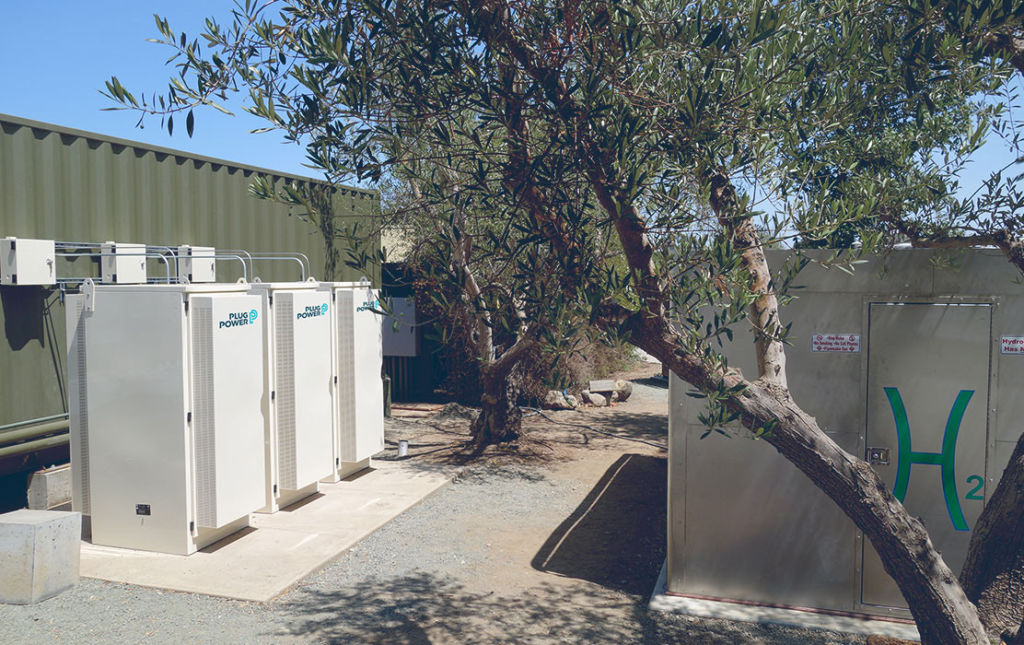Hydrogen Micro-Grids Could Solve California’s Energy Crisis
California winemakers face one of their toughest years on record, even for an industry accustomed to grappling with nature’s many challenges. Still reeling from the pandemic’s operational and economic impacts, the state’s vineyards are now confronting another record-breaking fire season. Even if the region’s vines survive intact, safety protocols adopted by the state’s utilities mean that rolling blackouts are now the “new normal.” Yet some local businesses, like Sonoma’s Stone Edge Farm Estate Vineyards & Winery, are seeing new benefits from their investments in clean energy. For these sustainability-minded operations, micro-grids powered by renewable energy provide reliable power and strengthen resilience to these overlapping crises while also ensuring they continue to meet their climate commitments.
Clean energy pioneers like Stone Edge provide a roadmap for other industries looking for innovative ways to meet their energy needs sustainably. As micro-grid technology advances and clean energy costs fall, more companies may find that unplugging from the grid is a viable solution to today’s energy challenges.
Switching Off the Utility
Stone Edge Farm has operated its own micro-grid since 2012. Five years later, as raging wildfires prompted electricity cuts, this self-contained energy system stepped in for the first time to cover the power needs for its essential operations, including water pumps, servers, and security systems. Since 2018, Stone Edge has operated without any electricity from the central grid. In fact, it’s the inverse: this state-of-the-art system is set up to sell its excess power back to the utility. What’s more, Stone Edge Farm’s micro-grid is supplied entirely by clean energy, allowing its facilities to run with better-than-net-zero carbon emissions.
Stone Edge Farm demonstrates how micro-grids provide a clean energy solution for California and other regions as they seek to address climate change without sacrificing a reliable power supply. So how does this game-changing technology work?
Simply defined, a micro-grid is a local energy grid that can operate on its own when disconnected from the utility-controlled grid. In the event of a blackout, microgrids switch into “island mode,” operating entirely autonomously. Traditionally, these systems have relied on fossil fuels—think of a diesel generator. How, then, are micro-grids fueling the clean-energy transition? The answer lies in green hydrogen.
Achieving Zero Carbon Energy with Electrolyzers
Stone Edge saw the benefits of green hydrogen early on. After struggling to power its operations through photovoltaic solar systems alone, owner Mac McQuown sought a more integrated solution. With the support of Omni Energy Solutions, Stone Edge installed a micro-grid that combines various clean energy technologies, including renewable electricity generation and battery and hydrogen storage, with real-time monitoring and control. The critical piece tying these components together is the a Plug Power electrolyzer, a machine that splits water molecules into oxygen and hydrogen via an electrochemical reaction. The extracted hydrogen is then stored on-site for later use by the Plug Power GenSure fuel cells that power the winery’s critical infrastructure or by its fuel cell-powered vehicles. This process enables Stone Edge Farm to run its business nearly emissions-free.

Yet, electrolyzers do more than produce portable hydrogen for fuel cells. When connected to renewable energy sources like the winery’s solar array, electrolyzers solve a critical issue that has long limited renewables’ competitiveness compared with oil, gas, and coal: intermittency. While nonrenewable energy sources can be turned on and off at will, solar and wind power fluctuate according to the time of day and the weather. Traditional grid operators must consistently balance electricity supply and demand, so renewable variability creates complications for utility planning.
But this dynamic also affects micro-grids. For Stone Edge Farm, their solar energy system was producing more electricity than its operations required, leading to surpluses of clean energy that went unused. Enter electrolyzer technology, which can convert the excess solar power into hydrogen, one of the most efficient and cost-effective energy carriers. As Stone Edge Farm looked into options for their larger scale electrolyzer, they chose Giner ELX (now Plug Power’s) 500 kW System demonstrating that megawatt and Multi-MW applications are now a reality. The excess hydrogen generated can be used not only to provide power to the farm and others, but shows to be of even greater value when used to provide fuel to fuel cell electric vehicles, as Stone Edge is set to do.
Investing in the Green Hydrogen Economy
Electrolyzer technology was pioneered decades ago, but it has only recently become viable as the clean energy transition linchpin. This is due to recent research into new manufacturing techniques and a surge in investments in hydrogen infrastructure, which are expected to push down the price of green hydrogen. Plug Power is at the forefront of this movement with its recent acquisition of Giner ELX, a global leader in electrolysis technology and grid-level renewable energy storage. With its vertical integration strategy, Plug Power is significantly expanding its supply capabilities to serve current and future customers, who are projected to use almost 100 tons of hydrogen per day by 2024 and at least half of this, will come from green hydrogen generated by Plug Power’s Multi-MW electrolyzer plants installed in strategic locations across the US.
The business case for green hydrogen-powered micro-grids – whether at low power or high power levels like those served by Plug Power’s recently-announced GenSure HP product suite – is well documented, spanning food manufacturing and retail distribution to automotive manufacturing, telecommunications, and railroads. More and more, though, it is the regulators who are driving conversations on how this technology can mitigate the increasingly visible risks of traditional energy systems. All this means that more businesses across industries will follow in Stone Edge’s footsteps as they navigate an evolving energy and regulatory landscape. Plug Power’s end-to-end green hydrogen solutions provide the pathways they need to transition to a resilient, zero-carbon energy future.
The post Hydrogen Micro-Grids Could Solve California’s Energy Crisis appeared first on Plug Power.